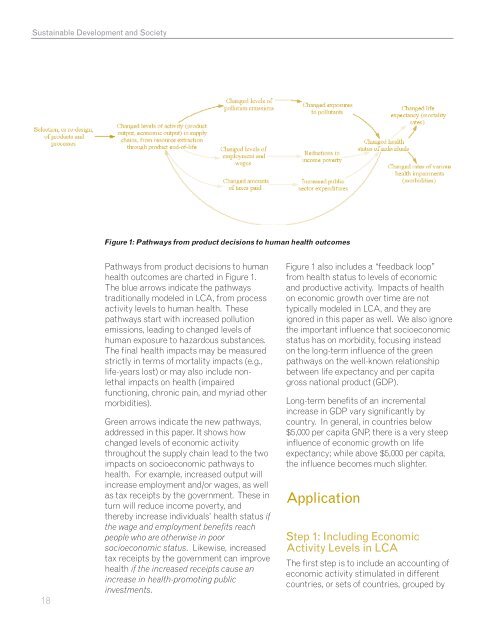Sustainable Development and Society - GSA
Sustainable Development and Society - GSA
Sustainable Development and Society - GSA
You also want an ePaper? Increase the reach of your titles
YUMPU automatically turns print PDFs into web optimized ePapers that Google loves.
<strong>Sustainable</strong> <strong>Development</strong> <strong>and</strong> <strong>Society</strong><br />
Figure 1: Pathways from product decisions to human health outcomes<br />
18<br />
Pathways from product decisions to human<br />
health outcomes are charted in Figure 1.<br />
The blue arrows indicate the pathways<br />
traditionally modeled in LCA, from process<br />
activity levels to human health. These<br />
pathways start with increased pollution<br />
emissions, leading to changed levels of<br />
human exposure to hazardous substances.<br />
The final health impacts may be measured<br />
strictly in terms of mortality impacts (e.g.,<br />
life-years lost) or may also include nonlethal<br />
impacts on health (impaired<br />
functioning, chronic pain, <strong>and</strong> myriad other<br />
morbidities).<br />
Green arrows indicate the new pathways,<br />
addressed in this paper. It shows how<br />
changed levels of economic activity<br />
throughout the supply chain lead to the two<br />
impacts on socioeconomic pathways to<br />
health. For example, increased output will<br />
increase employment <strong>and</strong>/or wages, as well<br />
as tax receipts by the government. These in<br />
turn will reduce income poverty, <strong>and</strong><br />
thereby increase individuals’ health status if<br />
the wage <strong>and</strong> employment benefits reach<br />
people who are otherwise in poor<br />
socioeconomic status. Likewise, increased<br />
tax receipts by the government can improve<br />
health if the increased receipts cause an<br />
increase in health-promoting public<br />
investments.<br />
Figure 1 also includes a “feedback loop”<br />
from health status to levels of economic<br />
<strong>and</strong> productive activity. Impacts of health<br />
on economic growth over time are not<br />
typically modeled in LCA, <strong>and</strong> they are<br />
ignored in this paper as well. We also ignore<br />
the important influence that socioeconomic<br />
status has on morbidity, focusing instead<br />
on the long-term influence of the green<br />
pathways on the well-known relationship<br />
between life expectancy <strong>and</strong> per capita<br />
gross national product (GDP).<br />
Long-term benefits of an incremental<br />
increase in GDP vary significantly by<br />
country. In general, in countries below<br />
$5,000 per capita GNP, there is a very steep<br />
influence of economic growth on life<br />
expectancy; while above $5,000 per capita,<br />
the influence becomes much slighter.<br />
Application<br />
Step 1: Including Economic<br />
Activity Levels in LCA<br />
The first step is to include an accounting of<br />
economic activity stimulated in different<br />
countries, or sets of countries, grouped by

















